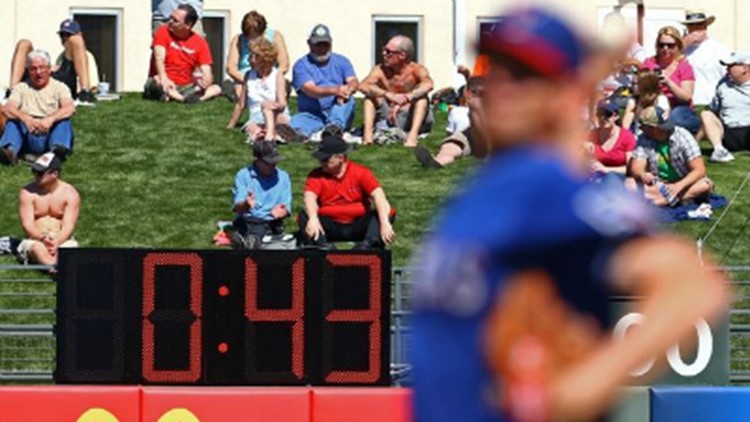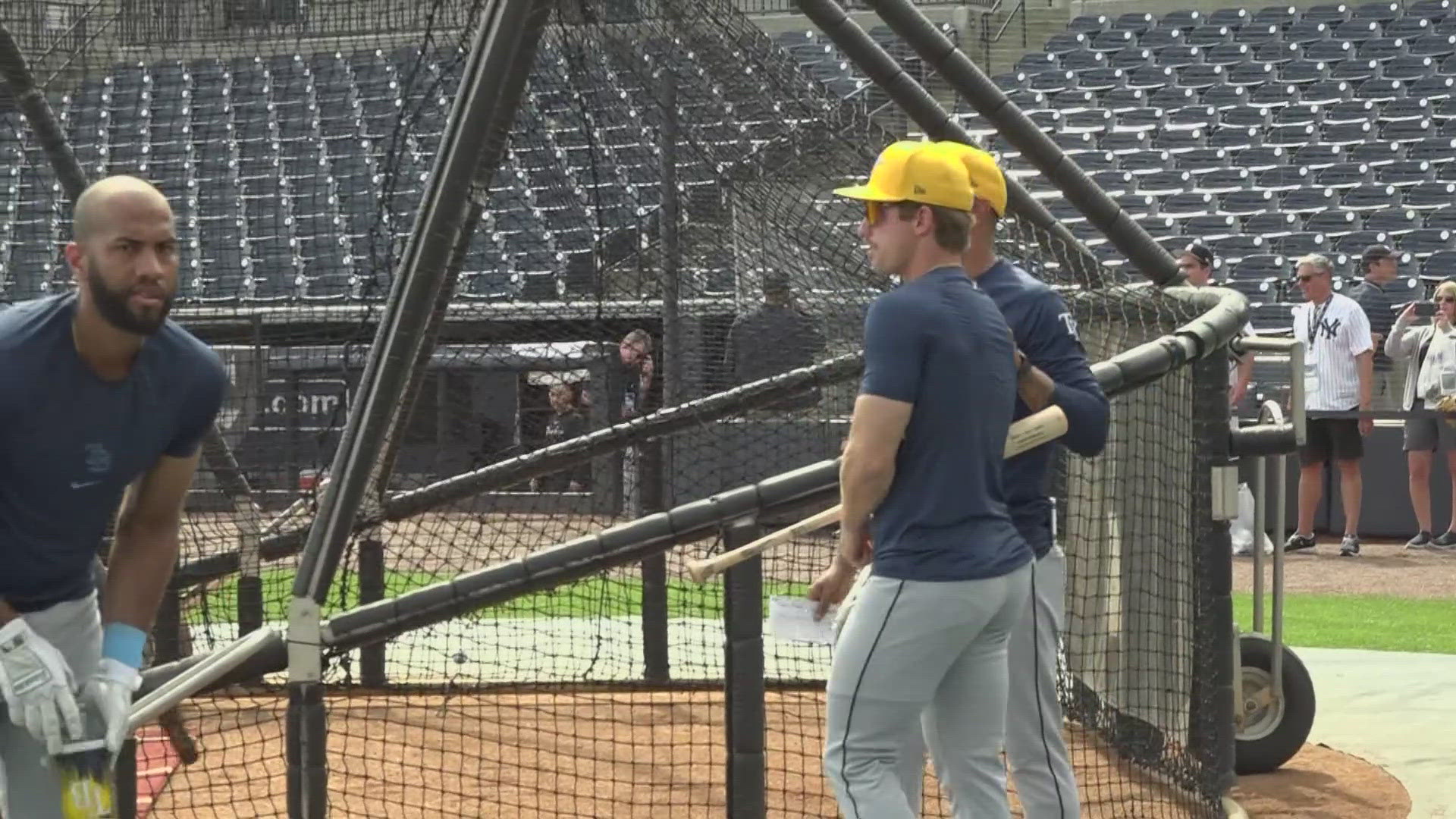Major League Baseball is expected to implement a pitch clock for the 2018 season.
Commissioner Rob Manfred and Major League Players Associations executive director Tony Clark have acknowledged the change, according to USA TODAY Sports’ Bob Nightengale.
Despite the union’s objections, Manfred has the right to unilaterally implement the pitch clock after this season under the provisions of the collective bargaining agreement, according to Nightengale.
Let’s review what the potential changes entail:
How did MLB come to this decision?
The average nine-inning MLB game takes three hours and five minutes this season, according to Baseball-Reference. If the figure holds, it would break the 2014 record of three hours and two minutes.
Year | Games | Average time per game | Average time of nine-inning games |
2017 | 1,326 | 3:09 | 3:05 |
2016 | 2,428 | 3:04 | 3:00 |
2015 | 2,429 | 3:00 | 2:56 |
2014 | 2,430 | 3:07 | 3:02 |
2013 | 2,431 | 3:04 | 2:58 |
2012 | 2,430 | 3:00 | 2:55 |
2011 | 2,429 | 2:56 | 2:51 |
2010 | 2,430 | 2:54 | 2:50 |
2009 | 2,430 | 2:55 | 2:51 |
2008 | 2,428 | 2:55 | 2:50 |
2007 | 2,431 | 2:55 | 2:51 |
2006 | 2,429 | 2:51 | 2:48 |
2005 | 2,431 | 2:49 | 2:46 |
2004 | 2428 | 2:51 | 2:47 |
2003 | 2,430 | 2:49 | 2:46 |
2002 | 2,426 | 2:56 | 2:52 |
2001 | 2,429 | 2:58 | 2:54 |
2000 | 2,429 | 3:01 | 2:57 |
The 2014 MLB season marked the first season the league expanded its video review process. Managers are allowed one challenged over the first six innings, and two from the seventh inning until the end of the game.
Perhaps the expanded video review process added to the length of an MLB game.
Is it a coincidence the first year of the expanded video review process also had the longest average of nine-inning games in the league’s 142-year history?
The league decided to limit the replay reviews to two minutes at the start of the 2017 season.
Inactivity during a game might also bother the league. About 33 percent of all at-bats result in a strikeout, a home run or a walk, according to USA TODAY.
Facebook Live discussion: What do you make of MLB’s decision to implement of a pitch clock for the 2018 season?
How would umpires enforce the pitch clock?
If a pitch isn't thrown within 20 seconds, a ball would be called. If the hitter isn't in the batter's box with five seconds remaining, a strike would be called.
Can you imagine an umpire issuing a ball or strike based on the clock during a tense playoff series, when games often take longer than the regular season? Would fans really want umpires to abide by the proposed pitch clock rules, or would umpires enforce playoff games differently than the regular season?
Minor League Baseball implemented the pitch clock at the Double-A and Triple-A levels before the start of the 2015 season.
Here’s a video example of an umpire enforcing the pitch clock rule during a 2014 Arizona Fall League game. No word on specifically how MLB would enforce a pitch clock with runners on base as shown in the video.
Here’s how the 20-second rule is explained at the minor league level with runners on base:
- The timer will stop as soon as the pitcher begins his wind-up, or begins the motion to come to the set position.
- If the pitcher feints a pick off or steps off the rubber with runners on base, the timer shall reset and start again immediately.
Which MLB pitchers take the longest and which work the fastest?
A stat called Pace is used to measure the average time between the pitches in a plate appearance. Go to FanGraphs’ website to read about the specifics of how it is measured.
The chart below shows a pitcher’s Pace.
Description | Pace (seconds) |
Fast | 20 |
Above Average | 20.5 |
Average | 21.5 |
Below Average | 22.5 |
Slow | 23.5 |
Here are the pitchers with the five slowest Paces in MLB so far during the 2017 season, according to FanGraphs:
Editor’s Note: Pitcher in bold: Average Pace (seconds)
- Yu Darvish, Texas Rangers: 26.2 seconds
- Alex Cobb, Tampa Bay Rays: 26.1 seconds
- Chris Archer, Tampa Bay Rays: 26.0 seconds
- Justin Verlander, Detroit Tigers: 26.0 seconds
- Jason Hammel, Kansas City Royals: 25.8 seconds
Here are the pitchers with the five fastest Paces in MLB so far during the 2017 season, according to FanGraphs:
Editor’s Note: Pitcher in bold: Average Pace (seconds)
- Carlos Martinez, St. Louis Cardinals: 19.6 seconds
- Wade Miley, Baltimore Orioles: 19.8 seconds
- Mike Leake, St. Louis Cardinals: 19.8 seconds
- Jason Vargas, Kansas City Royals: 20.2 seconds
- R.A. Dickey, Atlanta Braves: 20.3 seconds
While FanGraphs acknowledges Pace doesn't really affect performance, a key goal for a pitcher is to disrupt a hitter's timing. Is it possible putting a pitch clock in place could put pitchers at a disadvantage? Could hitters have similar problems with the requirement of being in the batter's box with five seconds remaining?
Who is MLB trying to appeal to with a new pitch clock?
Perhaps MLB is trying to speed up its games so people so fans can go to sleep at a reasonable hour, especially for fans in the Eastern Time zone.
Boston Red Sox pitcher Chris Sale threw the first pitch of Tuesday’s All-Star game around 8:22 p.m. ET. The 10-inning game didn’t finish until around 11:38 p.m. ET.
Popularity and business don't appear to be a problem.
This year’s Midsummer Classic drew in more viewers than last year, and ratings for the 2016 World Series were off the charts.
Forbes estimates the average MLB team is worth about $1.54 billion.
If the current business model isn’t broken, why try to fix it to appeal to someone who doesn’t watch or consume the product baseball has to offer?
Sport | Average Team Value (millions) |
NFL | $2,388 |
MLB | $1,537 |
Soccer (top 20 teams) | $1,468 |
NBA | $1,355 |
NHL | $517 |
The Associated Press reported the Double-A and Triple-A leagues with 20-second clocks cut their average games down by 12 minutes from 2014 to 2015. Is that saved time really going to appeal to an audience that can get a video recap on Twitter or YouTube almost immediately after a game?
Some 20 MLB games will also broadcast on Facebook Live this season. It’s clear the league is trying to keep with the times.
Time will tell if a pitch clock adds to a better on-field product and fan experience. There are two other potential rule changes that could leave baseball purists in an uproar:
- Adding further restrictions on visits the pitcher’s mound
- Starting extra innings with runners on base.
Once the 2017 season has come and gone, keep an eye out for these potential changes at the MLB Winter Meetings on Dec. 10-14.
Mark Bergin is a digital journalist with 10News WTSP. Like him on Facebook and follow him on Twitter and Instagram. You can also email him at mbergin@wtsp.com.



